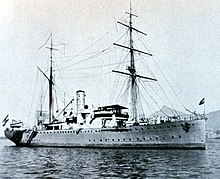Commemorative medal for the German Atlantic Expedition Meteor 1925–1927
The commemorative medal for the German Atlantic Expedition Meteor 1925–1927 , also known as the Meteor Medal for short , was commissioned by the then Emergency Association of German Science in Berlin (now the German Research Foundation ) at the end of 1927 and issued from 1928 onwards. The design comes from the German sculptor and medalist Theodor Georgii .
German Atlantic Expedition

The German Atlantic Expedition was one of the most important oceanographic expeditions of the 20th century . The Austrian-German marine scientist Dr. Alfred Merz planned a systematic hydrographic survey of the Atlantic Ocean . His proposal was approved by the Notgemeinschaft der Deutschen Wissenschaft in 1924. In order to be independent of fuel, the research trip took place with the survey ship Meteor . The Meteor was originally called by the Office draft 1913 gunboat for the German Imperial Navy built, but as such unfinished ship in the interwar years as a research vessel of the German after conversion 1923/24 Reichsmarine became known. The survey work took place in both the South Atlantic and the North Atlantic. The Meteor left Wilhelmshaven on April 16, 1925 and returned there on June 2, 1927. Despite his poor health, Metz was the leader of the expedition until his death in Buenos Aires in August 1925 . After his death, the German marine scientist Georg Wüst and the German naval officer Fritz Spieß took over the leadership of the expedition and brought it to a close. The meteor crossed the Atlantic four times to profiles of the ocean between 20 ° N and 55 ° S latitude to take. Scientists on board carried out 67,400 echo soundings between 310 hydrographic locations to map the topography of the seabed and made 9,400 measurements of temperature, salinity and chemical composition at different depths. With the analysis of the last mentioned measurements, a model of ocean currents , nutrient distribution and plankton growth could be created. Furthermore, for the first time extensive investigations into surface evaporation of water were carried out.
Appearance
The circular silver medal has a diameter of 41.5 mm and a weight of 25 g. All medals were made in the Bavarian Main Mint . On the front of a medal is a picture of the survey and research vessel Meteor under sails. A flying seagull is depicted on the reverse of the medal. Above it is the inscription "DEUTSCHE / ATLANTISCHE" and underneath the inscription "EXPEDITION / METEOR / 1925-27". On the upper side of a medal is a rectangular eyelet, on which there is an ornamental suspension in the form of a horizontal branch of laurel. The laurel branch consists of 23 leaves and five berries. On the edge of the medal, opposite the eyelet, it says “BAYER. MAIN MINT OFFICE. FINE SILVER ”. Each medal was tied on a light blue silk ribbon with white and dark gray 1 mm wide vertical stripes on both sides.
Classes and carriers
The medal came in two classes, with a gold-plated laurel branch (first class) and with a silver laurel branch (second class). 23 first class medals were awarded to officers and civil scientists, with 188 second class medals going to the crew. 123 men (10 officers, 29 NCOs, 78 sailors and 6 civil scientists) served on board the Meteor . The larger number of medals awarded is due to the fact that the crew changed during the voyage and medals were also given to people who were related to the expedition but were not on board.
Below are some of the people who received the Meteor Medal but were not part of the crew:
- Lotte Möller : She was a German geographer , hydrograph and marine biologist . As a woman, she was unable to take part in the research trip herself, as the Imperial Navy refused to do so. Instead, she took the samples on land and analyzed them in Berlin.
- Rudolf Lasarewitsch Samoilowitsch : He was a Russian-Soviet polar explorer and geologist who was the first foreign scholar to receive the Meteor Medal. Shortly before that, he reported to the Gesellschaft für Gekunde zu Berlin about his scientific observations during his journeys in the northern Arctic Ocean. In this context he reached the highest degree of latitude (81 ° 47 ') from Spitzbergen , up to which a ship had advanced in this area up to then. His information on ocean currents in the Arctic , land conditions and other information was considered to be of fundamental importance.
Individual evidence
- ^ Commemorative medal for the German Atlantic Expedition Meteor 1925-1927, presented by the Notgemeinschaft der Deutschen Wissenschaft , Secret State Archives of Prussian Cultural Heritage, December 14, 2005
- ↑ a b c Regine Stefani: The Sculptor Theodor Georgii, 1883-1963, biography and catalog raisonné (PDF document), dissertation, Ludwig Maximilians University Munich, Faculty of History and Art Studies 2011, p. 558
- ^ A b Fritz Spieß: The Meteor Expedition, Berlin, 1928
- ↑ a b Commemorative Medal for the German Atlantic Expedition Meteor 1925-1927 , antique-photos.com
- ↑ a b Commemorative Medal for the German Atlantic Expedition Meteor 1925-1927 , antarctic-circle.org
- ↑ Cornelia Lüdecke: Lotte Möller (1893–1973). First oceanography professor in German-speaking countries. In: Luminary. Volume 35, 2004, p. 39, ZDB -ID 644291-2
- ↑ Meteor Medal for Prof. Samoilowitsch ( Memento from October 5, 2017 in the Internet Archive ), Leipziger Jüdische Wochenschau, No. 15, April 12, 1929, p. 4.
